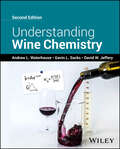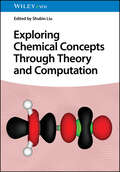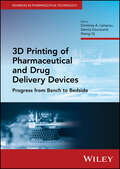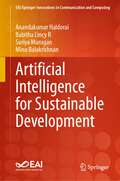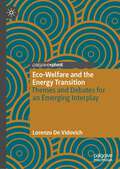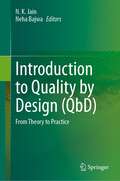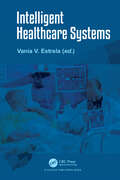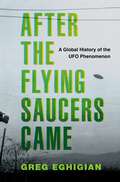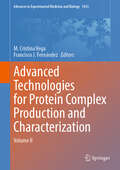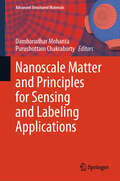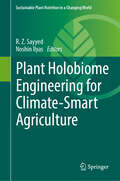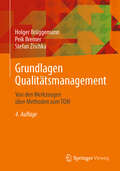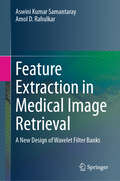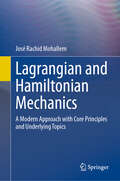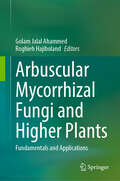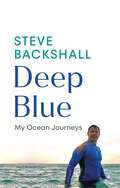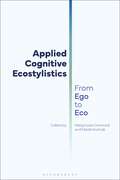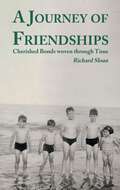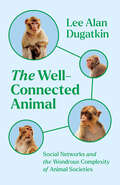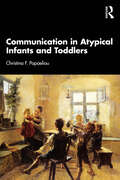- Table View
- List View
Understanding Wine Chemistry
by Andrew L. Waterhouse Gavin L. Sacks David W. JefferyUnderstanding Wine Chemistry Understand the reactions behind the world’s most alluring beverages The immense variety of wines on the market is the product of multiple chemical processes – whether acting on components arising in the vineyard, during fermentation, or throughout storage. Winemaking decisions alter the chemistry of finished wines, affecting the flavor, color, stability, and other aspects of the final product. Knowledge of these chemical and biochemical processes is integral to the art and science of winemaking. Understanding Wine Chemistry has served as the definitive introduction to the chemical components of wine, their properties, and their reaction mechanisms. It equips the knowledgeable reader to interpret and predict the outcomes of physicochemical reactions involved with winemaking processes. Now updated to reflect recent research findings, most notably in relation to wine redox chemistry, along with new Special Topics chapters on emerging areas, it continues to set the standard in the subject. Readers of the second edition of Understanding Wine Chemistry will also find: Case studies throughout showing chemistry at work in creating different wine styles and avoiding common adverse chemical and sensory outcomes Detailed treatment of novel subjects like non-alcoholic wines, non-glass alternatives to wine packaging, synthetic wines, and more An authorial team with decades of combined experience in wine chemistry research and education Understanding Wine Chemistry is ideal for college and university students, winemakers at any stage in their practice, professionals in related fields such as suppliers or sommeliers, and chemists with an interest in wine.
Exploring Chemical Concepts Through Theory and Computation
by Shubin LiuExploring Chemical Concepts Through Theory and Computation Deep, theoretical resource on the essence of chemistry, explaining a variety of important concepts including redox states and bond types Exploring Chemical Concepts Through Theory and Computation provides a comprehensive account of how the three widely used theoretical frameworks of valence bond theory, molecular orbital theory, and density functional theory, along with a variety of important chemical concepts, can between them describe and efficiently and reliably predict key chemical parameters and phenomena. By comparing the three main theoretical frameworks, readers will become competent in choosing the right modeling approach for their task. The authors go beyond a simple comparison of existing algorithms to show how data-driven theories can explain why chemical compounds behave the way they do, thus promoting a deeper understanding of the essence of chemistry. The text is contributed to by top theoretical and computational chemists who have turned computational chemistry into today’s data-driven and application-oriented science. Exploring Chemical Concepts Through Theory and Computation discusses topics including: Orbital-based approaches, density-based approaches, chemical bonding, partial charges, atoms in molecules, oxidation states, aromaticity and antiaromaticity, and acidity and basicityElectronegativity, hardness, softness, HSAB, sigma-hole interactions, charge transport and energy transfer, and homogeneous and heterogeneous catalysisElectrophilicity, nucleophilicity, cooperativity, frustration, homochirality, and energy decompositionChemical concepts in solids, excited states, spectroscopy and machine learning, and catalysis and machine learning, as well as key connections between related concepts Aimed at both novice and experienced computational, theoretical, and physical chemists, Exploring Chemical Concepts Through Theory and Computation is an essential reference to gain a deeper, more advanced holistic understanding of the field of chemistry as a whole.
3D Printing of Pharmaceutical and Drug Delivery Devices: Progress from Bench to Bedside (Advances in Pharmaceutical Technology)
by Dimitrios A. Lamprou Dennis Douroumis Sheng Qi3D Printing of Pharmaceutical and Drug Delivery Devices 3D Printing of Pharmaceutical and Drug Delivery Devices Discover the latest, fast-developing technology to help move towards more cost-effective, small-batch, decentralized manufacturing of personalized systems 3D printing has revolutionized manufacturing. Its precision and flexibility have enabled the large-scale production of materials and devices too complex for conventional industrial manufacturing. This has been particularly revolutionary in the field of pharmaceutical production, where 3D printing is being integrated into the manufacture of both drugs and drug delivery devices. It has never been more important for industry professionals to understand this form of production. 3D Printing of Pharmaceuticals and Drug Delivery Devices: Progress from Bench to Bedside offers a comprehensive overview of 3D printing technology and its pharmaceutical applications. It introduces readers to a world in which bespoke drug delivery systems developed for specific users or conditions is rapidly becoming a reality. Its detailed coverage of strategies and industrial processes incorporates the latest research and real-world experience of production. 3D Printing of Pharmaceuticals and Drug Delivery Devices: Progress from Bench to Bedside readers will also find: A multi-disciplinary authorial team of industry leadersDiscussion of common technical and regulatory barriers and their possible solutionsFar-ranging discussion of pharmaceutical applications across all sectors 3D Printing of Pharmaceuticals and Drug Delivery Devices: Progress from Bench to Bedside is essential reading for pharmaceutical industry professionals and researchers looking to occupy the leading edge.
Exploring Chemical Concepts Through Theory and Computation
by Shubin LiuExploring Chemical Concepts Through Theory and Computation Deep, theoretical resource on the essence of chemistry, explaining a variety of important concepts including redox states and bond types Exploring Chemical Concepts Through Theory and Computation provides a comprehensive account of how the three widely used theoretical frameworks of valence bond theory, molecular orbital theory, and density functional theory, along with a variety of important chemical concepts, can between them describe and efficiently and reliably predict key chemical parameters and phenomena. By comparing the three main theoretical frameworks, readers will become competent in choosing the right modeling approach for their task. The authors go beyond a simple comparison of existing algorithms to show how data-driven theories can explain why chemical compounds behave the way they do, thus promoting a deeper understanding of the essence of chemistry. The text is contributed to by top theoretical and computational chemists who have turned computational chemistry into today’s data-driven and application-oriented science. Exploring Chemical Concepts Through Theory and Computation discusses topics including: Orbital-based approaches, density-based approaches, chemical bonding, partial charges, atoms in molecules, oxidation states, aromaticity and antiaromaticity, and acidity and basicityElectronegativity, hardness, softness, HSAB, sigma-hole interactions, charge transport and energy transfer, and homogeneous and heterogeneous catalysisElectrophilicity, nucleophilicity, cooperativity, frustration, homochirality, and energy decompositionChemical concepts in solids, excited states, spectroscopy and machine learning, and catalysis and machine learning, as well as key connections between related concepts Aimed at both novice and experienced computational, theoretical, and physical chemists, Exploring Chemical Concepts Through Theory and Computation is an essential reference to gain a deeper, more advanced holistic understanding of the field of chemistry as a whole.
3D Printing of Pharmaceutical and Drug Delivery Devices: Progress from Bench to Bedside (Advances in Pharmaceutical Technology)
by Dimitrios A. Lamprou Dennis Douroumis Sheng Qi3D Printing of Pharmaceutical and Drug Delivery Devices 3D Printing of Pharmaceutical and Drug Delivery Devices Discover the latest, fast-developing technology to help move towards more cost-effective, small-batch, decentralized manufacturing of personalized systems 3D printing has revolutionized manufacturing. Its precision and flexibility have enabled the large-scale production of materials and devices too complex for conventional industrial manufacturing. This has been particularly revolutionary in the field of pharmaceutical production, where 3D printing is being integrated into the manufacture of both drugs and drug delivery devices. It has never been more important for industry professionals to understand this form of production. 3D Printing of Pharmaceuticals and Drug Delivery Devices: Progress from Bench to Bedside offers a comprehensive overview of 3D printing technology and its pharmaceutical applications. It introduces readers to a world in which bespoke drug delivery systems developed for specific users or conditions is rapidly becoming a reality. Its detailed coverage of strategies and industrial processes incorporates the latest research and real-world experience of production. 3D Printing of Pharmaceuticals and Drug Delivery Devices: Progress from Bench to Bedside readers will also find: A multi-disciplinary authorial team of industry leadersDiscussion of common technical and regulatory barriers and their possible solutionsFar-ranging discussion of pharmaceutical applications across all sectors 3D Printing of Pharmaceuticals and Drug Delivery Devices: Progress from Bench to Bedside is essential reading for pharmaceutical industry professionals and researchers looking to occupy the leading edge.
Artificial Intelligence for Sustainable Development (EAI/Springer Innovations in Communication and Computing)
by Anandakumar Haldorai Babitha Lincy R Suriya Murugan Minu BalakrishnanThis book delves into the synergy between AI and sustainability. This comprehensive guide illuminates the latest trends and cutting-edge techniques, offering invaluable insights for researchers, practitioners, and policymakers interested in the cross-section of AI and sustainability. The authors illustrate how AI-driven innovations are revolutionizing environmental conservation, urban planning, healthcare, and more. The book also considers the ethical considerations and governance frameworks crucial to harnessing AI's potential for global benefit. Whether a seasoned expert or a curious newcomer, this book empowers readers to navigate the dynamic landscape of AI and sustainability, paving the way for a more eco-conscious and equitable world.
Eco-Welfare and the Energy Transition: Themes and Debates for an Emerging Interplay
by Lorenzo De VidovichThis book provides a comprehensive overview of the emerging interplay that runs between energy – seen as a basic need and a providential material service from the viewpoint of welfare studies – and eco-welfare, seen as an emerging analytical and policy paradigm that hold together the social crisis on the one hand, and the ecological crisis, on the other hand. At a time of energy transition, the interplay between the theoretical framework of eco-welfare and the topic of energy supply is little explored, and therefore, this book fills a need in the literature by providing a comprehensive framework to navigate this emerging relationship. Such a framework is strengthened by insights on energy poverty and renewable energy communities, identified as cornerstones of the analysis between energy transition and eco-welfare.
Introduction to Quality by Design (QbD): From Theory to Practice
by N. K. Jain Neha BajwaThis book offers a comprehensive exploration of the Quality by Design (QbD) methodology, guiding readers from theory to practical application with accessible examples. It equips readers with both foundational and advanced knowledge, emphasizing the critical parameters necessary for designing pharmaceutical products that meet the highest quality standards. The book goes beyond theory to demonstrate how to effectively implement QbD principles in various aspects of pharmaceutical research and development, including analytical methods, formulation, and packaging processes. Through a step-by-step approach, it prepares researchers in pharmaceutical sciences, as well as professionals in the pharmaceutical and healthcare industries (including suppliers), to successfully integrate QbD into their work.
Intelligent Healthcare Systems
by Vania V. EstrelaThe book sheds light on medical cyber-physical systems while addressing image processing, microscopy, security, biomedical imaging, automation, robotics, network layers’ issues, software design, and biometrics, among other areas. Hence, solving the dimensionality conundrum caused by the necessity to balance data acquisition, image modalities, different resolutions, dissimilar picture representations, subspace decompositions, compressed sensing, and communications constraints. Lighter computational implementations can circumvent the heavy computational burden of healthcare processing applications. Soft computing, metaheuristic, and deep learning ascend as potential solutions to efficient super-resolution deployment. The amount of multi-resolution and multi-modal images has been augmenting the need for more efficient and intelligent analyses, e.g., computer-aided diagnosis via computational intelligence techniques. This book consolidates the work on artificial intelligence methods and clever design paradigms for healthcare to foster research and implementations in many domains. It will serve researchers, technology professionals, academia, and students working in the area of the latest advances and upcoming technologies employing smart systems’ design practices and computational intelligence tactics for medical usage. The book explores deep learning practices within particularly difficult computational types of health problems. It aspires to provide an assortment of novel research works that focuses on the broad challenges of designing better healthcare services.
After the Flying Saucers Came: A Global History of the UFO Phenomenon
by Greg EghigianRoswell, 1947. Washington, DC, 1952. Quarouble, 1954. New Hampshire, 1961. Pascagoula, 1973. Petrozavodsk, 1977. Copley Woods, 1983. Explore how sightings of UFOs and aliens seized the world's attention and discover what the fascination with flying saucers and extraterrestrial visitors says about our changing views on science, technology, and the paranormal. In the summer of 1947, a private pilot flying over the state of Washington saw what he described as several pie pan-shaped aircraft traveling in formation at remarkably high speed. Within days, journalists began referring to the objects as "flying saucers." Over the course of that summer, Americans reported seeing them in the skies overhead. News quickly spread, and within a few years, flying saucers were being spotted across the world. The question on everyone's mind was, what were they? Some new super weapon in the Cold War? Strange weather patterns? Optical illusions? Or perhaps it was all a case of mass hysteria? Some, however, concluded they could only be one thing: spacecrafts built and piloted by extraterrestrials. The age of the unidentified flying object, the UFO, had arrived. Greg Eghigian tells the story of the world's fascination with UFOs and the prospect that they were the work of visitors from outer space. While accounts of great wonders in the sky date back to antiquity, reports of UFOs took place against the unique backdrop of the Cold War and space age, giving rise to disputed government inquiries, breathtaking news stories, and single-minded sleuths. After the Flying Saucers Came traces how a seemingly isolated incident sparked an international drama involving shady figures, questionable evidence, suspicions of conspiracy, hoaxes, new religions, scandals, unsettling alien encounters, debunkers, and celebrities. It examines how descriptions, theories, and debates about unidentified flying objects and alien abduction changed over time and how they appeared in the United States, Europe, Latin America, Asia, and Russia. And it explores the impact UFOs have had on our understanding of space, science, technology, and ourselves up through the present day. Replete with stories of the people who have made up the ufology community, the military and defense units that investigate them, the scientists and psychologists who have researched these unexplained encounters, and the many novels, movies, TV shows, and websites that have explored these phenomena, After the Flying Saucers Came speaks to believers and skeptics alike.
After the Flying Saucers Came: A Global History of the UFO Phenomenon
by Greg EghigianRoswell, 1947. Washington, DC, 1952. Quarouble, 1954. New Hampshire, 1961. Pascagoula, 1973. Petrozavodsk, 1977. Copley Woods, 1983. Explore how sightings of UFOs and aliens seized the world's attention and discover what the fascination with flying saucers and extraterrestrial visitors says about our changing views on science, technology, and the paranormal. In the summer of 1947, a private pilot flying over the state of Washington saw what he described as several pie pan-shaped aircraft traveling in formation at remarkably high speed. Within days, journalists began referring to the objects as "flying saucers." Over the course of that summer, Americans reported seeing them in the skies overhead. News quickly spread, and within a few years, flying saucers were being spotted across the world. The question on everyone's mind was, what were they? Some new super weapon in the Cold War? Strange weather patterns? Optical illusions? Or perhaps it was all a case of mass hysteria? Some, however, concluded they could only be one thing: spacecrafts built and piloted by extraterrestrials. The age of the unidentified flying object, the UFO, had arrived. Greg Eghigian tells the story of the world's fascination with UFOs and the prospect that they were the work of visitors from outer space. While accounts of great wonders in the sky date back to antiquity, reports of UFOs took place against the unique backdrop of the Cold War and space age, giving rise to disputed government inquiries, breathtaking news stories, and single-minded sleuths. After the Flying Saucers Came traces how a seemingly isolated incident sparked an international drama involving shady figures, questionable evidence, suspicions of conspiracy, hoaxes, new religions, scandals, unsettling alien encounters, debunkers, and celebrities. It examines how descriptions, theories, and debates about unidentified flying objects and alien abduction changed over time and how they appeared in the United States, Europe, Latin America, Asia, and Russia. And it explores the impact UFOs have had on our understanding of space, science, technology, and ourselves up through the present day. Replete with stories of the people who have made up the ufology community, the military and defense units that investigate them, the scientists and psychologists who have researched these unexplained encounters, and the many novels, movies, TV shows, and websites that have explored these phenomena, After the Flying Saucers Came speaks to believers and skeptics alike.
Advanced Technologies for Protein Complex Production and Characterization: Volume II (Advances in Experimental Medicine and Biology #1453)
by M. Cristina Vega Francisco J. FernándezThis edited volume discusses the identification, discovery, characterization, structure determination and modeling of multicomponent macromolecular complexes, and as such, it fully complements the first volume (ISBN 978-3-319-27214-6), which targeted methods of recombinant production of protein complexes. This book is divided in 8 sections offering a selection of technologies widely used in the characterization of protein and protein-nucleic acid complexes for different purposes and at different scales. From native electrophoresis methods, that are accessible to any reasonably well-equipped laboratory, to the sophisticated setup required for structure determination by cryo-electron microscopy or X-ray crystallography, this book contains a wide variety of clearly explained analytic and preparative approaches, connected with the production techniques developed on the previous volume. The readers will find an integral connection between this book and the first volume, which ensures a comprehensive and updated discussion of the main topics of the discipline. Taken together, these volumes constitute a cohesive and authoritative source of the research on multicomponent macromolecular complexes. In here, we focus on characterization of protein complexes in the broadest sense, which is not typically covered in other sources. Moreover, all chapters are carefully written by world renowned scientists and active researchers, making this volume ideal, not only as a reference source, but also as a companion book for the daily laboratory work. This book is aimed for a wide range of scientists, from science students to experienced researchers, working on protein and protein-nucleic acid complexes, who need a thorough understanding of protein production and complex characterization.
Nanoscale Matter and Principles for Sensing and Labeling Applications (Advanced Structured Materials #206)
by Dambarudhar Mohanta Purushottam ChakrabortyThis book is a compilation of carefully chosen chapters that cover the subjects of nanoscale matter, sensing, and labelling applications. It is aimed primarily at scientists and researchers who are already involved in theme-based research or who are just starting their careers. Despite the diverse nature of the topics covered, which include a range of materials in various forms and uses, the emphasis is primarily on sensing and labelling phenomena. The book begins with materials quantification in nanoscale systems by using an innovative technique like “molecular secondary ion mass spectrometry without calibration standards”. Subsequently, the book features an array of materials such as inorganic semiconductor nanoscale particles, carbon dots, rare-earth oxides, polymer nanocomposites, and a few biomaterials, all of which illustrate their functionality and potential for deployment in a wide variety of sensing applications. Although the book delves into the technical aspects of fabrication workouts to some extent, the focus is predominantly on the physical principles, mechanisms, and relevance involved in sensing and labelling applications. The book covers a wide range of topics that leverage the unique properties of nanoscale materials. By carefully selecting appropriate active materials, the authors explore the detection of LPG, hazardous and explosive gases, as well as humidity sensing and hydrogen evolution. It also delves into photo-sensing and persistent photoconductivity by using nanoscale semiconductors, which are used for heavy metal sensing and UV sensing, respectively. The use of metal nanoparticles in various forms is reviewed to address issues related to water contamination, biofilm protection, and food-borne pathogens. The book also discusses surface plasmon resonance, starting with its basic principles and expanding to its relevance in a broader perspective, with a greater focus on applied biosensing. Nanoscale ferrites and magnetic systems are explored with an emphasis on magnetic sensing and actuation. Lastly, the book explores the use of rare-earth-based nanosystems, highlighting persistent luminescence and up/down-converted transitions, which have unprecedented applications in bioimaging and biolabeling. Every effort has been made to strike a balance between the observed phenomena in the emerging areas of sensing applications and suitable theoretical treatments there in.
Plant Holobiome Engineering for Climate-Smart Agriculture (Sustainable Plant Nutrition in a Changing World)
by R. Z. Sayyed Noshin IlyasThis edited volume is an inclusive collection of information on crop holobiome, their function and diversity, the plausible role of soil microbes in crop growth, protection from pathogens and stresses, the use of resilient microbiomes for changing climate, and the use of new technologies to study plant-insect-microbe molecular interactions in agricultural systems.Holobiomes provide information about both plants and their microbiomes, which gives a more comprehensive insight, particularly for changing climatic scenarios. By optimizing the crop holobime function crop productivity and plant health can be enhanced manifold. This book deep dives into the numerous ways in which holobiome supports the improving plant health, nutrient uptake, disease control, and stress resistance in major food crops. It helps researchers, academicians, agri-entrepreneurs, and technologists understand the structure and function of holobiomes in crop growth, health, stress tolerance under climatic changes, and holobiome diversity and evolution. The book is also helpful in designing new dimensions in the holobiome research and development of new products and technologies.This volume is of interest and useful to agriculture scientists, microbiologists, ecologists, and is a valuable source of reference to researchers and students. This volume is of interest and useful to agriculture scientists, microbiologists, ecologists, and is a valuable source of reference to researchers and students.This volume is of interest and useful to agriculture scientists, microbiologists, ecologists, and is a valuable source of reference to researchers and students.This volume is of interest and useful to agriculture scientists, microbiologists, ecologists, and is a valuable source of reference to researchers and students.This volume is of interest and useful to agriculture scientists, microbiologists, ecologists, and is a valuable source of reference to researchers and students.This volume is of interest and useful to agriculture scientists, microbiologists, ecologists, and is a valuable source of reference to researchers and students.This volume is of interest and useful to agriculture scientists, microbiologists, ecologists, and is a valuable source of reference to researchers and students.This volume is of interest and useful to agriculture scientists, microbiologists, ecologists, and is a valuable source of reference to researchers and students.This volume is of interest and useful to agriculture scientists, microbiologists, ecologists, and is a valuable source of reference to researchers and students.This volume is of interest and useful to agriculture scientists, microbiologists, ecologists, and is a valuable source of reference to researchers and students.This volume is of interest and useful to agriculture scientists, microbiologists, ecologists, and is a valuable source of reference to researchers and students.This volume is of interest and useful to agriculture scientists, microbiologists, ecologists, and is a valuable source of reference to researchers and students.This volume is of interest and useful to agriculture scientists, microbiologists, ecologists, and is a valuable source of reference to researchers and students.This volume is of interest and useful to agriculture scientists, microbiologists, ecologists, and is a valuable source of reference to researchers and students.This volume is of interest and useful to agriculture scientists, microbiologists, ecologists, and is a valuable source of reference to researchers and students.This volume is of interest and useful to agriculture scientists, microbiologists, ecologists, and is a valuable source of reference to researchers and students.This volume is of interest a
Grundlagen Qualitätsmanagement: Von den Werkzeugen über Methoden zum TQM
by Holger Brüggemann Peik Bremer Stefan ZischkaDieses Lehrbuch beschreibt in leicht verständlicher und praxisorientierter Darstellung die relevanten Grundlagen des Qualitätsmanagements. Dabei wird der Bogen von den elementaren Qualitätswerkzeugen über die klassischen Qualitätsmethoden und Qualitätsmanagement-Systeme bis zu neueren Ansätzen aus dem Bereich Smart Quality/Qualität 4.0 gespannt. Somit bekommen Leser*innen einen guten Überblick über die Thematik. Kontrollfragen und Übungsaufgaben mit Antworten und Lösungen ermöglichen leicht ein erfolgreiches Selbststudium. Die aktuelle Auflage wurde durchgesehen, aktualisiert und überarbeitet.
Feature Extraction in Medical Image Retrieval: A New Design of Wavelet Filter Banks
by Aswini Kumar Samantaray Amol D. RahulkarMedical imaging is fundamental to modern healthcare, and its widespread use has resulted in creation of image databases. These repositories contain images from a diverse range of modalities, multidimensional as well as co-aligned multimodality images. These image collections offer opportunity for evidence-based diagnosis, teaching, and research. Advances in medical image analysis over last two decades shows there are now many algorithms and ideas available that allow to address medical image analysis tasks in commercial solutions with sufficient performance in terms of accuracy, reliability and speed. Content-based image retrieval (CBIR) is an image search technique that complements the conventional text-based retrieval of images by using visual features, such as color, texture, and shape, as search criteria. This book emphasizes the design of wavelet filter-banks as efficient and effective feature descriptors for medical image retrieval.Firstly, a generalized novel design of a family of multiplier-free orthogonal wavelet filter-banks is presented. In this, the dyadic filter coefficients are obtained based on double-shifting orthogonality property with allowable deviation from original filter coefficients. Next, a low complex symmetric Daub-4 orthogonal wavelet filter-bank is presented. This is achieved by slightly altering the perfect reconstruction condition to make designed filter-bank symmetric and to obtain dyadic filter coefficients. In third contribution, the first dyadic Gabor wavelet filter-bank is presented based on slight alteration in orientation parameter without disturbing remaining Gabor wavelet parameters. In addition, a novel feature descriptor based on the design of adaptive Gabor wavelet filter-bank is presented. The use of Maximum likelihood estimation is suggested to measure the similarity between the feature vectors of heterogeneous medical images. The performance of the suggested methods is evaluated on three different publicly available databases namely NEMA, OASIS and EXACT09. The performance in terms of average retrieval precision, average retrieval recall and computational time are compared with well-known existing methods.
Lagrangian and Hamiltonian Mechanics: A Modern Approach with Core Principles and Underlying Topics
by José Rachid MohallemThis book serves as a textbook for an analytical mechanics course, a fundamental subject of physics, that pays special attention to important topics that are not discussed in most standard textbooks. Readers are provided with a clear understanding of topics that are usually inaccessible to the undergraduate level and that are critical to learning Lagrangian and Hamiltonian mechanics. Each chapter also includes worked problems and solutions, as well as additional exercises for readers to try. This book begins with the fundamentals of analytical mechanics, concisely introducing readers to the calculus of variations, Hamilton’s Principle, and Lagrange’s equations. While presenting readers with these core topics, the author uses an intuitive approach to delve into essential questions, such as where Galilean invariance lies in Lagrangian mechanics and how Hamilton’s Principle of Least Action encompasses Newton’s three laws, interesting conclusions that often go unnoticed. Infact, Hamilton’s principle is taken throughout as the very origin of classical physical laws, and the choice of appropriate Lagrangians in each case as the real theoretical challenge, meaning that forms of Lagrangian which differ from the standard one are not mere curiosities but, instead, the general rule. This book clarifies common misunderstandings that students face when learning the subject and formally rationalizes concepts that are often difficult to grasp. In addition, the final chapter provides an introduction to a Lagrangian field theory for those interested in learning more advanced topics. Ideal for upper undergraduate and graduate students, this book seeks to teach the intrinsic meaning of the principles and equations taught in an analytical mechanics course and convey their usefulness as powerful theoretical instruments of modern physics.
Arbuscular Mycorrhizal Fungi and Higher Plants: Fundamentals and Applications
by Golam Jalal Ahammed Roghieh HajibolandThis book covers the fundamentals of arbuscular mycorrhizal fungi (AMF) and higher plant symbiosis with potential implications in crop production. It provides new insights into our understanding of the mechanisms of AMF-mediated plant growth regulation and stress tolerance covering the most recent biochemical, physiological, molecular, environmental, and ecological studies. Focusing on AMF-induced physiological and molecular mechanisms of enhanced tolerance to stress, environmental stress is discussed in several dedicated chapters. The book provides not only updated information with new insights and perspectives but also several new topics, such as a comprehensive discussion on biotic stressors, AMF interaction with other microorganisms, non-host plant species, plant secondary metabolism, signaling events in plant-AMF symbiosis, AMF-mediated nutrient acquisition and subsequent stress tolerance. The book also discusses the potential implications of AMF for sustainable crop production inthe context of climate change. The book can be a useful reference book for academics and scientists involved in related research, such as academics in agronomy and plant sciences, scientists involved in beneficial fungi research, chemists, industrialists, and employees involved in the production and marketing of biofertilizers, master and doctoral degree students of agronomy, horticulture, and plant protection, consultants working on the production of crops in marginal environments as well as environmental scientists working for assisted phytoremediation programs. It would also be suitable for agronomy, ecology, and plant science-related courses, such as plant stress physiology, plant growth-promoting microbes, and plant pathology to teach undergraduate, graduate, and postgraduate students at colleges and universities.
Deep Blue: My Ocean Journeys
by Steve BackshallTake a deep breathSteve Backshall was nine years old the first time he saw a shark, while on holiday with his family in Malaysia. It was the beginning of a life-long fascination with these 'lords of the sea', and the oceanic life around them. His career as one of the world's most popular naturalists and explorers has taken him to countless underwater places, many never before seen by others. And he's also been witness to the startling decline in fortune of our oceans' wild inhabitants over the past fifty years.Deep Blue is a book a lifetime in the making: a remarkable blend of memoir, travel, and marine and environmental science that takes us on an unforgettable tour of the many worlds of aquatic life: from underwater deserts and rainforests to the evolution of ocean heroes like the sea turtle and the Great White, from the genesis of ocean life to the rapidly declining state of white polar seas and coral reefs. It's both a love letter to our precious oceans and rallying cry for what we must to do save them.
Applied Cognitive Ecostylistics: From Ego to Eco
by Malgorzata Drewniok, Marek Kuźniak, andThis book offers an up-to-date account of one of the most influential strands of eco-research: cognitive ecostylistics. The onset of the 1970s saw a global shift in scholarly perspective upon the relation between egocentric and ecocentric views of the world. The so-called eco-turn was not only linguistic at its roots, but engaged the bulk of academic thought in social sciences and humanities. Cognitive ecostylistics invites a multidisciplinary approach to the study of the conceptual relations between oral or written texts and their impact on the environment. This volume is a collection of the latest research that seeks to apply the theory and methodology developed over the last 40 years to both literary and real-life texts, engaging with a wealth of examples from First World War poetry and Anne of Green Gables through to Condé Nast Traveller hotel descriptions. Exploring the cultural effects of the eco-turn, the collection engages the reader in the problem of the present-day Anthropocene, manifested as Ego-Eco tensions at the level of communicating self-needs and the needs of the Other. Divided into two parts, it considers first the human-angled semiotic interplay contained within the universe of people, before examining the problem of semiotic engagement of texts as extraneous to the human, highlighting crucial aspects of nature, culture, and beyond.
Applied Cognitive Ecostylistics: From Ego to Eco
This book offers an up-to-date account of one of the most influential strands of eco-research: cognitive ecostylistics. The onset of the 1970s saw a global shift in scholarly perspective upon the relation between egocentric and ecocentric views of the world. The so-called eco-turn was not only linguistic at its roots, but engaged the bulk of academic thought in social sciences and humanities. Cognitive ecostylistics invites a multidisciplinary approach to the study of the conceptual relations between oral or written texts and their impact on the environment. This volume is a collection of the latest research that seeks to apply the theory and methodology developed over the last 40 years to both literary and real-life texts, engaging with a wealth of examples from First World War poetry and Anne of Green Gables through to Condé Nast Traveller hotel descriptions. Exploring the cultural effects of the eco-turn, the collection engages the reader in the problem of the present-day Anthropocene, manifested as Ego-Eco tensions at the level of communicating self-needs and the needs of the Other. Divided into two parts, it considers first the human-angled semiotic interplay contained within the universe of people, before examining the problem of semiotic engagement of texts as extraneous to the human, highlighting crucial aspects of nature, culture, and beyond.
A Journey of Friendships: Cherished Bonds woven through Time
by Richard SloanThe themes running through the book are friends and friendships. It is not an academic study of friendship. It is about the relationships with some of the people the author has encountered during his life. Readers will be able to define for themselves whom they regard as good, best, close etc. friends. This book should act as a catalyst for them to arrive at these definitions. The book shows how the class ceiling was broken by his liberal thinking parents, university education and marriage. He made deep interclass friendships. He was brought up with a live-in nanny, housekeeper, gardener etc. His mother was brought up old money and upper class in Germany. Several of his friends are professors and the human sides of these and those who taught him are demonstrated. His friendship and love of Frank, his brother, a merchant navy radio officer, resulted in his love of the sea and cruising with his parents and friends. During the pandemic lockdowns of 2020/21, his garden became a friend. His relationship with the garden was a major factor in preventing loneliness and depression. Social therapeutic gardens. A significant involvement with science in his early life supplied him with an enquiring mind and involved deep working relationships with fellow scientists. Some of the scientific work undertaken jointly with his PhD supervisor, W R Keatinge, as described. Was he a friend? Since his wife died in 2015, social media and electronic means of communicating have kept him in close touch with friends and others. The evolution and some history of these modes of communication used by the author over 50 years and are described. He was actively in politics in the earl 1980s. Political work creates friendships and camaraderie amongst campaigners.
The Well-Connected Animal: Social Networks and the Wondrous Complexity of Animal Societies
by Lee Alan DugatkinAn engaging exploration of the wondrous social webs that permeate life in animal societies around the world. It’s all about who you know. Whether vampire bats sharing blood meals for survival, field crickets remembering champion fighters, macaque monkeys forming grooming pacts after a deadly hurricane, or great tit birds learning the best way to steal milk—it pays to be well connected. In this tour of the animal kingdom, evolutionary biologist Lee Alan Dugatkin reveals a new field of study, uncovering social networks that existed long before the dawn of human social media. He accessibly describes the latest findings from animal behavior, evolution, computer science, psychology, anthropology, genetics, and neurobiology, and incorporates interviews and insights from researchers he finds swimming with manta rays, avoiding pigeon poop, and stopping monkeys from stealing iPads. With Dugatkin as our guide, we investigate social networks in giraffes, elephants, kangaroos, Tasmanian devils, whales, bats, and more. From animal networks in Australia and Asia to Africa, Europe, and the Americas, The Well-Connected Animal is an eye-opening exposé of wild friends, enemies, and everything in between.
The Well-Connected Animal: Social Networks and the Wondrous Complexity of Animal Societies
by Lee Alan DugatkinAn engaging exploration of the wondrous social webs that permeate life in animal societies around the world. It’s all about who you know. Whether vampire bats sharing blood meals for survival, field crickets remembering champion fighters, macaque monkeys forming grooming pacts after a deadly hurricane, or great tit birds learning the best way to steal milk—it pays to be well connected. In this tour of the animal kingdom, evolutionary biologist Lee Alan Dugatkin reveals a new field of study, uncovering social networks that existed long before the dawn of human social media. He accessibly describes the latest findings from animal behavior, evolution, computer science, psychology, anthropology, genetics, and neurobiology, and incorporates interviews and insights from researchers he finds swimming with manta rays, avoiding pigeon poop, and stopping monkeys from stealing iPads. With Dugatkin as our guide, we investigate social networks in giraffes, elephants, kangaroos, Tasmanian devils, whales, bats, and more. From animal networks in Australia and Asia to Africa, Europe, and the Americas, The Well-Connected Animal is an eye-opening exposé of wild friends, enemies, and everything in between.
Communication in Atypical Infants and Toddlers
by Christina F. PapaeliouThis book presents a comparative review of the latest studies and data on prelinguistic communication and early semantic development in autism spectrum disorder (ASD), Williams syndrome (WMS), attention-deficit/hyperactivity disorder (ADHD), and early language delay. Papaeliou offers a critical analysis of the literature, compares key theoretical approaches, and interprets data on development in atypical populations.A fruitful synthesis of theory and research reveals that, instead of cognitive deficits, the core feature of these neurodevelopmental disorders consists of deficits in the ability for self- and intersubjective coordination, which adversely affects early interactions and, consequently, the emergence of language. The book composes fragmentary proposals on the role of rhythm disruptions in different conditions, setting out the idea that disruption in interactional synchrony is a connecting thread through neurodevelopmental disorders which show high prevalence or high comorbidity rates. Papaeliou identifies distinct communicative patterns characteristic of each disorder and puts forward a unifying theory for interpreting data on early communication and language development in atypical populations.This is ideal reading for psychologists, psycholinguists, psychiatrists, paediatricians, speech therapists, and special educators. Students in developmental psychology and anyone interested in understanding the research behind typical and atypical development will also benefit from this text.
